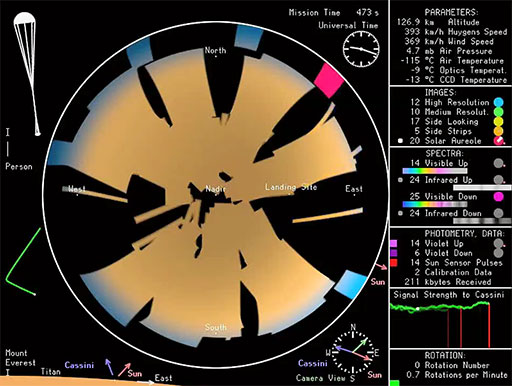2.3 Descent to Titan
This video allows you to see (and hear) the data collected by the Huygens lander during its descent. Four hours is compressed to less than five minutes.
The first part of the video shows how Titan appeared to the camera as it acquired more and more images during the probe’s descent. Each image has a small field of view and dozens of images were made into mosaics of the whole scene. The view is pretty boring until Huygens passes through the smog layer.
The video includes sidebar graphics that show:
- (Lower left corner) Huygens’ trajectory views from the south, with a scale bar for comparison with the height of Mount Everest; coloured arrows point to the Sun and to the Cassini orbiter.
- (Top left corner) A close-up view of the Huygens lander highlighting large and unexpected parachute movements; there is a scale bar for comparison with human height.
- (Lower right corner) A compass that shows the changing direction of view as Huygens rotates, along with the relative positions of the Sun and the Cassini orbiter.
- (Upper right corner) A clock that shows Universal Time for 14 January 2005 (Universal Time is the same as GMT). Above the clock, events are listed in mission time, which starts with the deployment of the first of the three parachutes.
Sounds from a left speaker trace Huygens’ motion, with tones changing with rotational speed and the tilt of the parachute. There are also clicks that track the rotational counter and sounds for the probe’s heat shield hitting Titan’s atmosphere, parachute deployments, heat shield release, jettison of the camera cover and touchdown.
Sounds from a right speaker go with the Descent Imager/Spectral Radiometer activity. A continuous tone represents the strength of Huygens’ signal to the Cassini orbiter, which then relayed the signal to the Earth. Various chimes denote data acquisition by Huygens’ on-board instruments.
After landing, you see a colour image and a series of black-and-white images from the surface, which continue until contact is lost, but the view of a footprint on the left is an Apollo image of the surface of the Moon to show you the scale of the Titan surface view.

For another way of visualizing the descent, take a look at this video [Tip: hold Ctrl and click a link to open it in a new tab. (Hide tip)] that blends Cassini images with Huygens images.
